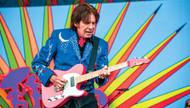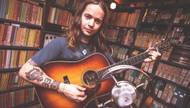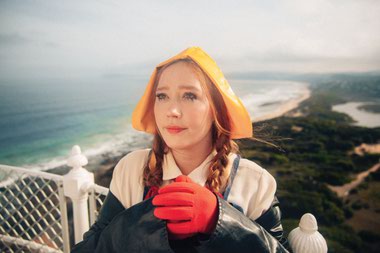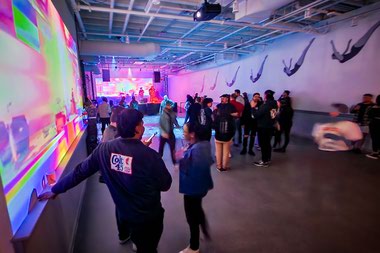In the search for unifying themes to sum up this year’s Coachella and where it sits on the festival’s evolutionary chart, the easy commentary is how indie and throwback alternative rock—once the signature sound of the fest (with electronic music close behind)—has largely fallen out of favor with festivalgoers and, subsequently, the talent bookers. It’s generational, it’s cultural, it’s cyclical—it’s all been said before. But one thing that stuck out on the festival’s final day—and, in hindsight, the rest of the weekend—is the unabashed earnestness of Coachella’s musical slate and millennial faithful.
You could see it just reading Sunday's performer roster: the traditional soul of Lee Fields and the Expressions, the socio-politically charged, gender-fluid singer/songwriter Ezra Furman (who pontificated from the Outdoor Stage and even took shots at Philip Anschutz of AEG, the partial owner of Coachella), the open-hearted alt-pop of Group love, the hippy folk of Devendra Banhart, and the fists-up punk of T.S.O.L.
You could see it in Toots and the Maytals, who followed Fields on the main stage and continued the feel-good, nostalgic afternoon vibes at the main stage. Toots Hibbert’s “Pressure Drop,” performed on Sunday, is one the classic fight-the-power anthems of the reggae genre, about a government that abuses its power. He was singing about his decades-old marijuana-possession arrest, but the song’s themes remain as relevant as ever. The band balanced consciousness with escapism later in the set, with a healthy dose of crowd participation to help the small crowd shake off its final-day hangover.
You could see it in the pre-sunset performance of Future Islands and especially its lead singer Sam Herring. While the music would seem subversive coming from an indie-electronic group fronted by a dude who looks like an accountant but growls like a metal singer, it’s anything but. On Sunday, Herring sang about the human condition against a sonic backdrop of dramatic new wave synths, innervating 4/4 beats and strident post-punk basslines. And while his famously awkward dance moves and heavy sentimentalism grew wince-worthy at times, there was no questioning his intentions or dedication—and the midsized Outdoor Theatre crowd ate up every minute of it, from well-known anthems like “Seasons (Waiting on You)” and “Ran” to older cuts like the more aggressive “Tin Man.” Herring has not only found his heart, but stuck it firmly on his sleeve.
You could see it in the main-stage B2B set by Porter Robinson and Madeon, a widely anticipated set due to how well their 2016 Shelter tour had been received, how Coachella was serving as the tour’s conclusion and how their performance was the sole electronic dance set at the fest’s biggest stage, where DJs Calvin Harris and Kaskade had previously conquered with record-breaking crowds. This was more of a live set, with the two producer/DJs trading off and mashing their material, which is refreshingly devoid of the drops, squelches, 4/4 bombardments, color-by-numbers structures and synth novelties of commercial EDM. (They also occasionally played drums/percussion and sang.) But that's not why Robinson and Madeon drew such a large crowd on Sunday. Both artists’ songs are highly emotive—some recalling slower-tempoed versions of late-1990s trance music—and the sunset audience basked in (and sang along to) the open-hearted melodies. Occasionally it felt overbearing, but the overall result was a communal show of optimism and idealism, minus any on-the-nose PLUR references, that has long been a thematic cornerstone of electronic dance music culture.
You could see it in the widescreen performance by movie composer Hans Zimmer and his orchestra, the sleeper set of Sunday, if not the entire weekend. Part of the draw for the enormous Outdoor Theatre crowd was the mere sight of a large orchestra on a stage usually reserved for five guys. But most of it was the lure of swelling, soaring and occasionally pounding music associated with some of the biggest movies of the past three decades, from Gladiator and Pirates of the Caribbean to the Dark Knight trilogy. In a surprise segment, Pharrell Williams appeared to sing during “Freedom,” a song he crafted with Zimmer for last year’s Hidden Figures. But no moment bowled onlookers over like the opening African chant by exiled singer Lebo M for “Circle of Life,” which began a three-song suite from The Lion King. More than Robinson and Madeon—more than maybe any other song played all weekend—the main theme from the most beloved children’s movie of the past 25 years spoke to the audience. When Zimmer and orchestra—which also included guitarists, vocalists and keyboard/synth players to add a dynamic, contemporary touch—closed with the final “Circle” refrain, they were joined by one of the loudest crowd singalongs I've ever heard. Could any display be less self-conscious than tens of thousands of people singing the theme to a Disney cartoon at the top of their lungs at the world’s trendiest music festival?
And then there was headliner Kendrick Lamar, who dropped his new studio album, Damn., on Friday, and reminded his substantial main-stage audience of this in banter and by playing eight of its numbers (for the very first time). At first impression, it would seem Lamar hasn't shied from the serious topics—especially race and police violence, but also spiritual crisis—that marked his 2015 Grammy-winning album To Pimp a Butterfly. The rapper’s most searing performance Sunday night came from the one-two punch of the newer “XXX” and older “M.A.A.D.,” highlighted by numerous flashing red and blue lights and blaring police sirens. The segment overshadowed all three guest performances—earlier Coachella acts Travis Scott, Schoolboy Q and Future, who all sang their own songs and were joined by Lamar—and the few upbeat tracks, though unfatigued audience members were willing to jump up and raise their hands in jubilation to pretty much anything.
Lamar also employed a few tricks, including a levitating platform in the middle of the crowd and a massive, Kanye-esque, overhead platform that projected images of launched rockets and Muhammad Ali training for a fight. Ironically, none were more effective than the irreverent, Far East-inspired skits he starred in and projected on the stage’s giant wraparound screens throughout the set. “Kung Fu Kenny” not only added some dimension to both the set’s visual presentation and Lamar’s persona, but it balanced out the weightiness of the material performed with some fun and loose metaphors. It was also silly—the series ended with Lamar finding his “glow” … in his crotch—but after a weekend overflowing with sincerity and urgency, both Lamar and the audience had earned some moments of levity.









